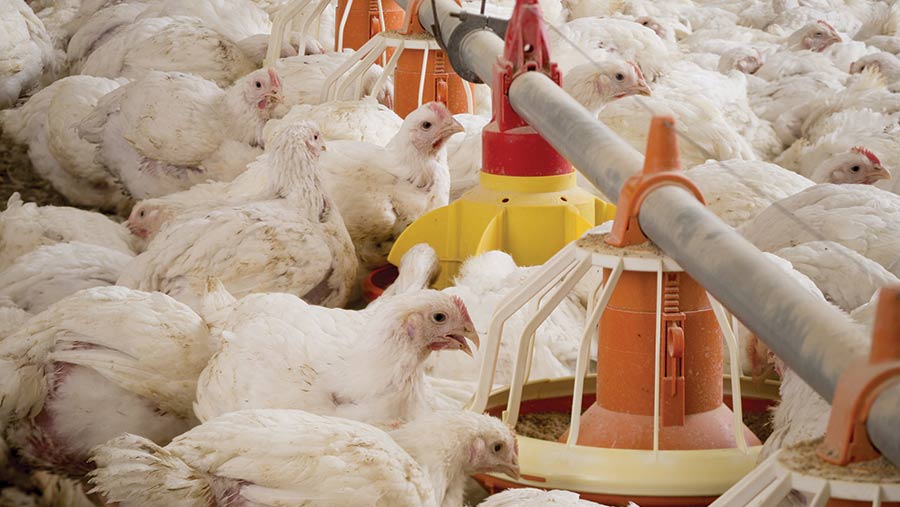How proteases can save on feed costs in broiler rations
 © Jim Varney
© Jim Varney Protein is one of the most expensive ingredients in broiler diets, so must be used efficiently.
Fortunately, adding protease can increase the nutritional value of most protein-containing raw materials, meaning that less needs to be fed to achieve the same level of growth.
If, by using protease, broilers are getting more from soya, then less is required, so reducing the environmental impact associated with growing and importing this ingredient.
Other environmental benefits include reduced nitrogen excretion and ammonia emissions.
See also: New pea variety could help poultry absorb more protein
What are proteases?
Proteases are enzymes produced naturally by the gastro-intestinal tract of broilers, allowing digestion of protein in feed.
More recently, commercially produced microbial proteases have become available, and these can be added to poultry diets in the same way as phytases and carbohydrases.
By working in synergy with the animal’s own protease enzymes, they improve protein digestion further, which in turn increases both broiler performance and profitability.
How proteases work
Amino acids, supplied by feed raw materials, aren’t fully digested by broilers. The fraction that remains undigested acts as a substrate for a commercially produced protease.
The effect will vary depending on many factors, including the feed ingredient, type of amino acid and age of the bird.
Proteases may be particularly valuable in young birds that are fed high levels of protein, at a time when their digestive systems are still immature.
Protease use can also help to stabilise soya bean quality from batch to batch. Soya can, if inadequately processed, contain trypsin inhibitors, which reduce the activity of the bird’s own protein-digesting enzymes.
This affects growth rate and feed efficiency, and is also linked with increased feed passage rate and deterioration in litter quality.
Commercially produced proteases are different, as rather than being inhibited they will actually degrade trypsin inhibitors, preventing these negative effects.
Cost of protein ingredients
As protein is the second most expensive nutrient in broiler diets, improving the efficiency of use can enhance profitability.
Trials supplementing broiler diets with proteases have shown that ileal digestibility of amino acids is increased on average by 4%.
The advantage is that broiler diets can be reformulated with reduced levels of amino acids and crude protein, without losing performance (see graph below). This can reduce feed costs by up to 1.5p/bird.
But these improvements in weight gain and feed conversion are often more than can be accounted for by improved amino acid availability alone.
Scientists increasingly believe that this is related to the role a protease can play in improving gut health and integrity.
Optimising gut health
Feeding high levels of protein to broilers has been shown to increase the levels of E coli and Clostridium perfringens in the gut. This is because they feed on the undigested protein reaching the hindgut.
These bacteria have a detrimental effect on the gut health of broilers and subsequently their performance. Poor gut health leads to wet litter and more footpad dermatitis.
As well as the welfare implications, producers who exceed acceptable levels of footpad dermatitis, have to reduce stocking density from 39kg/m sq to 33kg/m sq under EU law, which reduces profitability.
By lowering crude protein levels in the diet, gut health is improved and birds also drink less water, both of which are positive for litter condition.
Growth would normally be adversely affected by such diets, but here a protease can help. By improving protein utilisation, the use of a low-protein diet becomes possible, without seeing a drop in performance.
Investigations have also demonstrated that gut integrity can be improved (see graph below). Less damage to the villi, reduced mucin levels and reduced epithelial thickness are seen, boosting gut health status.
Environmental impact
Environmental legislation has the potential to limit the expansion of the broiler industry. Novel approaches need to be found to meet this challenge.
Undigested protein in manure gives rise to ammonia, nitrate and nitrous oxide, all of which are detrimental to the environment.
Studies have demonstrated that use of a protease, particularly with lower protein diets, can be beneficial for the environmental impact of broiler production.
Things such as global warming potential, eutrophication potential and acidification potential can all be reduced as a result of lower ammonia emissions (see graph below).
The manure produced by broilers fed lower protein diets also contains less nitrogen.
This means that less land is needed to dispose of manure in those areas where there are restrictions on the amount of nitrogen that can be applied.
Additionally, if less soya is required, then less fertiliser is needed for its growth and the amount leached into the environment is reduced.
Opportunities for proteases
To see the maximum benefits, proteases should be formulated into the diet by a nutritionist.
Suppliers of proteases provide values for the improvement in amino acid digestibility of each raw material.
Amino acid and protein levels can then be reduced, allowing cost savings and performance improvements to be balanced with the aims of the producer.
However, feed cost savings are not the whole story.
The addition of a protease typically replaces 2% of the soya bean meal in a broiler diet, and increased levels of wheat generally fill the space created in the formulation.
This has a beneficial effect on the environment and the economics of broiler production.
Adding proteases to low-protein diets has been shown to save between £1.50/t and £4.50/t of feed, together with marked benefits on litter quality and carcass quality.
Dr Adam Smith is market development manager for feed enzymes at DSM Nutritional Products.



